Rapid Calibration of Nanoliter per Second Flow Rate by Image Processing Technology
(This article belongs to the Section E:Engineering and Technology)
Abstract
1. Introduction
2. Experimental System
2.1. Flow Supply System and Liquid
2.2. Gravimetric Method
2.3. Image Processing Technology
3. Results and Discussion
3.1. Results of the Gravimetric Method
3.2. Results of Image Processing Technology
4. Conclusions
Author Contributions
Funding
Data Availability Statement
Conflicts of Interest
References
- Wang, Y.; Zhang, X.; Shang, L.; Zhao, Y. Thriving Microfluidic Technology. Sci. Bull. 2021, 66, 9–12. [Google Scholar] [CrossRef] [PubMed]
- Milyukov, V.K. TianQin Space-Based Gravitational Wave Detector: Key Technologies and Current State of Implementation. Astron. Rep. 2020, 64, 1067–1077. [Google Scholar] [CrossRef]
- Liu, H.; Niu, X.; Zeng, M.; Wang, S.; Cui, K.; Yu, D. Review of Micro Propulsion Technology for Space Gravitational Waves Detection. Acta Astronaut. 2022, 193, 496–510. [Google Scholar] [CrossRef]
- Krejci, D.; Lozano, P. Space Propulsion Technology for Small Spacecraft. Proc. IEEE 2018, 106, 362–378. [Google Scholar] [CrossRef]
- Bock, D.; Bethge, M.; Tajmar, M. Highly miniaturized feep thrusters for cubesat applications. In Proceedings of the 4th Spacecraft Propulsion Conference, Cologne, Germany, 19–22 May 2014. [Google Scholar]
- Hu, C.; Fan, S.; Zheng, D. The Approaches and Development of the Micro Flow Measurement. Metrol. Meas. Technol. 2015, 35, 1–8. [Google Scholar]
- Kotreshappa, S.L.; Nayak, C.G.; Venkata, S.K. A Review on the Role of Microflow Parameter Measurements for Microfluidics Applications. Systems 2023, 11, 113. [Google Scholar] [CrossRef]
- Li, Y.; Jiang, X.; Zhou, Z.; Ye, X. Flow Characteristics of Microducted Fluid. Chin. Mech. Eng. 1994, 5, 24–25+43. [Google Scholar]
- Bissig, H.; Petter, H.T.; Lucas, P.; Batista, E.; Filipe, E.; Almeida, N.; Ribeiro, L.F.; Gala, J.; Martins, R.; Savanier, B.; et al. Primary Standards for Measuring Flow Rates from 100 Nl/Min to 1 Ml/Min—Gravimetric Principle. Biomed. Eng. Biomed. Tech. 2015, 60, 301–316. [Google Scholar] [CrossRef]
- Richter, M.; Woias, P.; Weiβ, D. Microchannels for Applications in Liquid Dosing and Flow-Rate Measurement. Sens. Actuators A Phys. 1997, 62, 480–483. [Google Scholar] [CrossRef]
- Han, W.; Wang, H. Study on Micro-flow Rate Measurement Method Based on Construction of Three-dimensional Velocity. Chin. J. Sci. Instrum. 2012, 33, 413–420. [Google Scholar] [CrossRef]
- Xie, H.; Fu, X.; Yang, H. Micro-PIV Based Micro Flow Visualization Technology. Chin. J. Mech. Eng. 2005, 41, 106–111. [Google Scholar] [CrossRef]
- Kontakis, K.; Petropoulos, A.; Kaltsas, G.; Speliotis, T.; Gogolides, E. A Novel Microfluidic Integration Technology for PCB-Based Devices: Application to Microflow Sensing. Microelectron. Eng. 2009, 86, 1382–1384. [Google Scholar] [CrossRef]
- Lötters, J.C.; Lammerink, T.S.J.; Groenesteijn, J.; Haneveld, J.; Wiegerink, R.J. Integrated Thermal and Microcoriolis Flow Sensing System with a Dynamic Flow Range of More Than Five Decades. Micromachines 2012, 3, 194–203. [Google Scholar] [CrossRef]
- Batista, E.; Álvares, M.; Martins, R.F.; Ogheard, F.; Geršl, J.; Godinho, I. Measurement of Internal Diameters of Capillaries and Glass Syringes Using Gravimetric and Optical Methods for Microflow Applications. Biomed. Eng. Biomed. Tech. 2023, 68, 29–38. [Google Scholar] [CrossRef] [PubMed]
- Uchizono, N.M.; Collins, A.L.; Thuppul, A.; Wright, P.L.; Eckhardt, D.Q.; Ziemer, J.; Wirz, R.E. Emission Modes in Electrospray Thrusters Operating with High Conductivity Ionic Liquids. Aerospace 2020, 7, 141. [Google Scholar] [CrossRef]
- Wright, P.; Thuppul, A.; Wirz, R.E. Life-Limiting Emission Modes for Electrospray Thrusters. In Proceedings of the 2018 Joint Propulsion Conference, Cincinnati, OH, USA, 9 July 2018. [Google Scholar]
- Thurow, K.; Krüger, T.; Stoll, N. An Optical Approach for the Determination of Droplet Volumes in Nanodispensing. J. Autom. Methods Manag. Chem. 2009, 2009, 198732. [Google Scholar] [CrossRef] [PubMed]
- Song, Q.; Zhang, G.-X.; Qiu, Z. Image Processing Technology Used for Drop Volume Calculation. Opt. Technol. 2004, 30, 321–323. [Google Scholar]
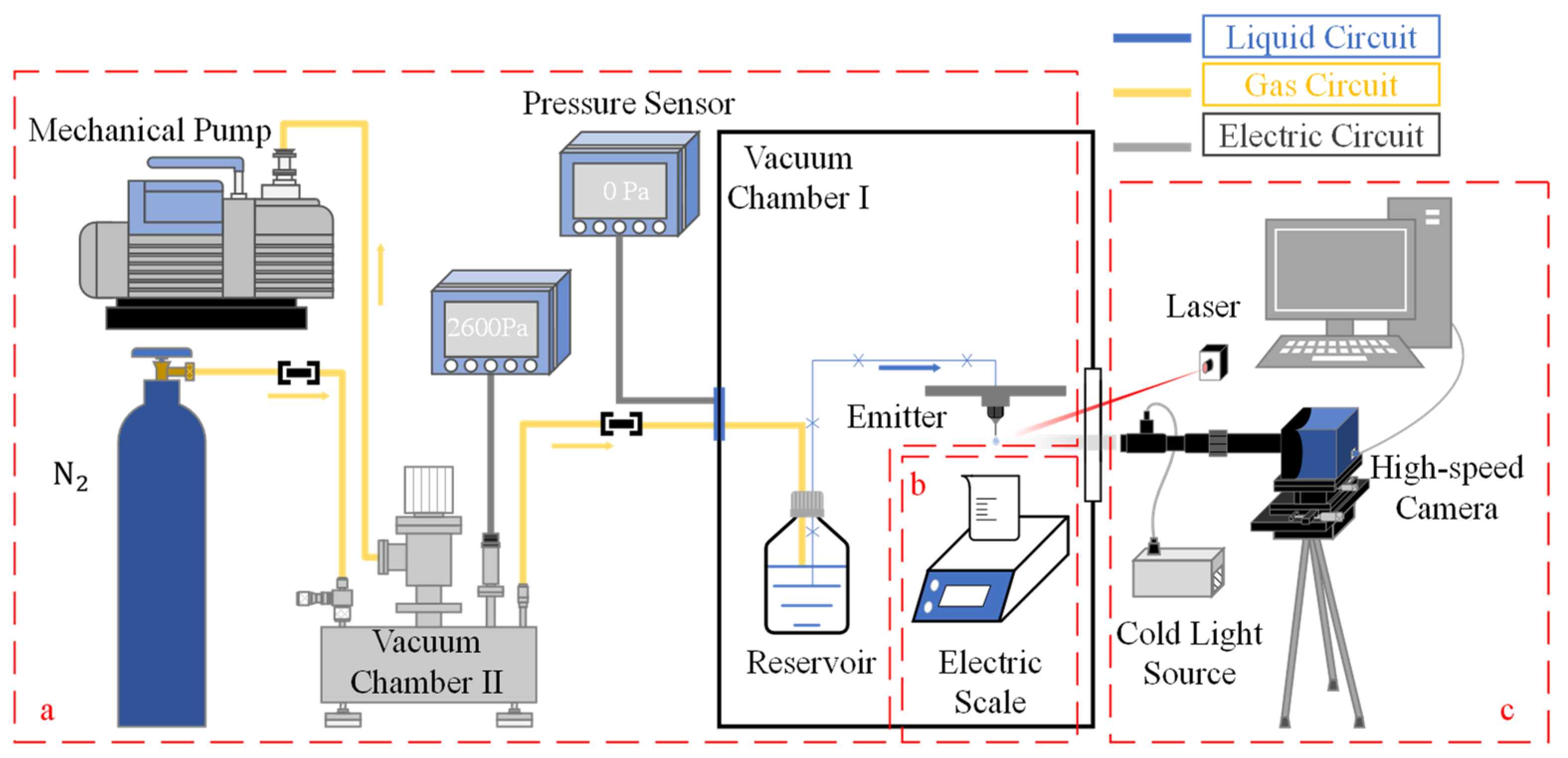


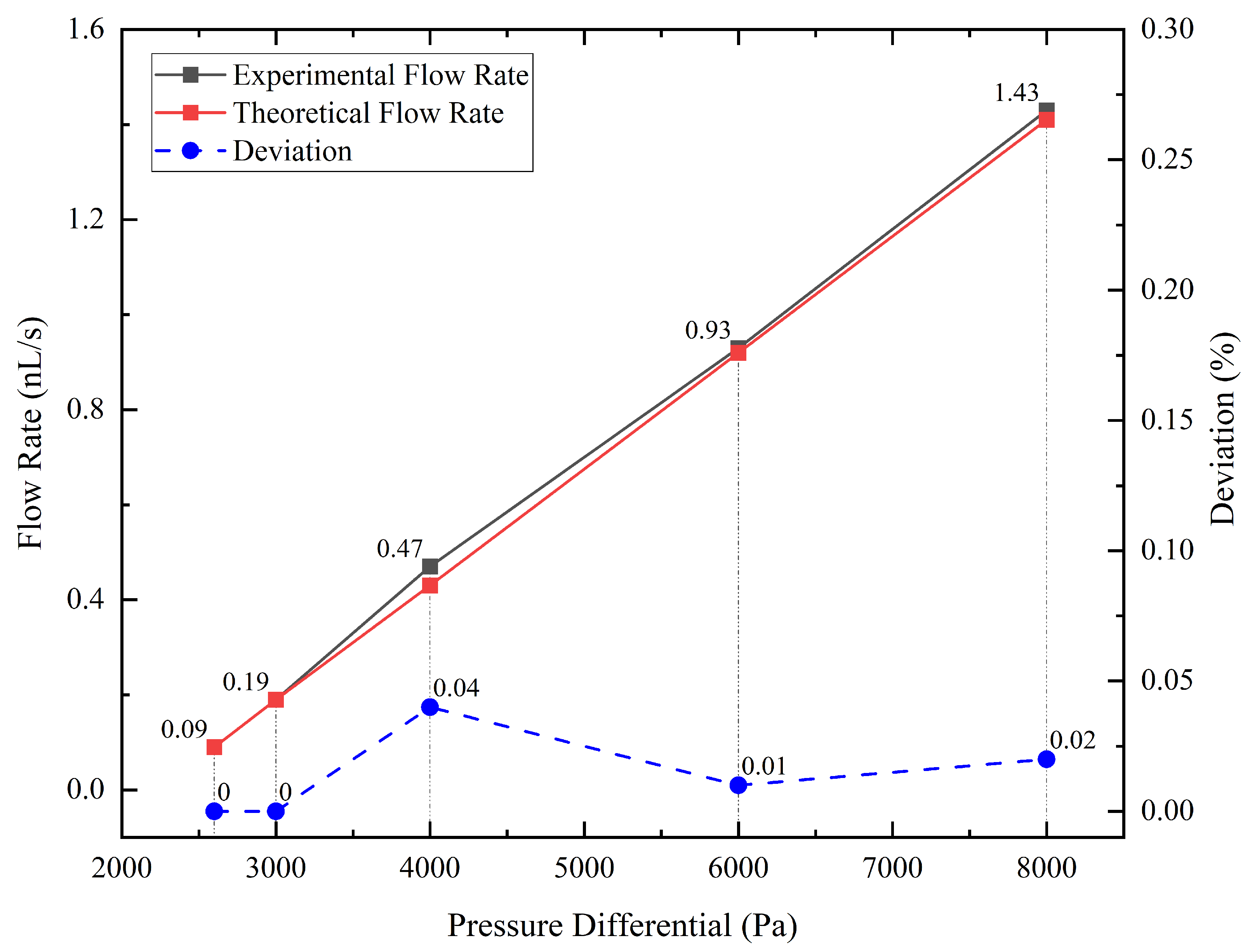
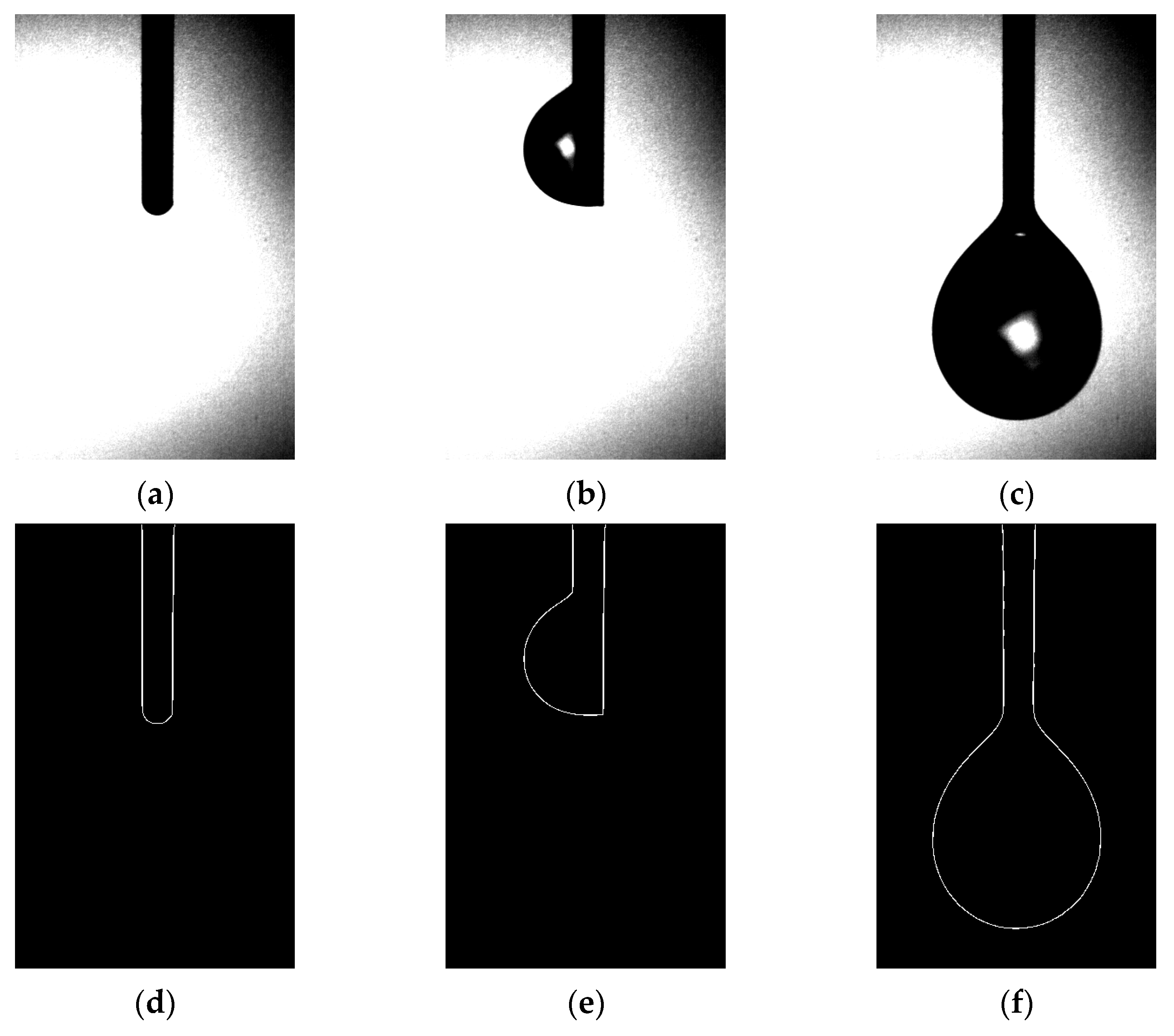
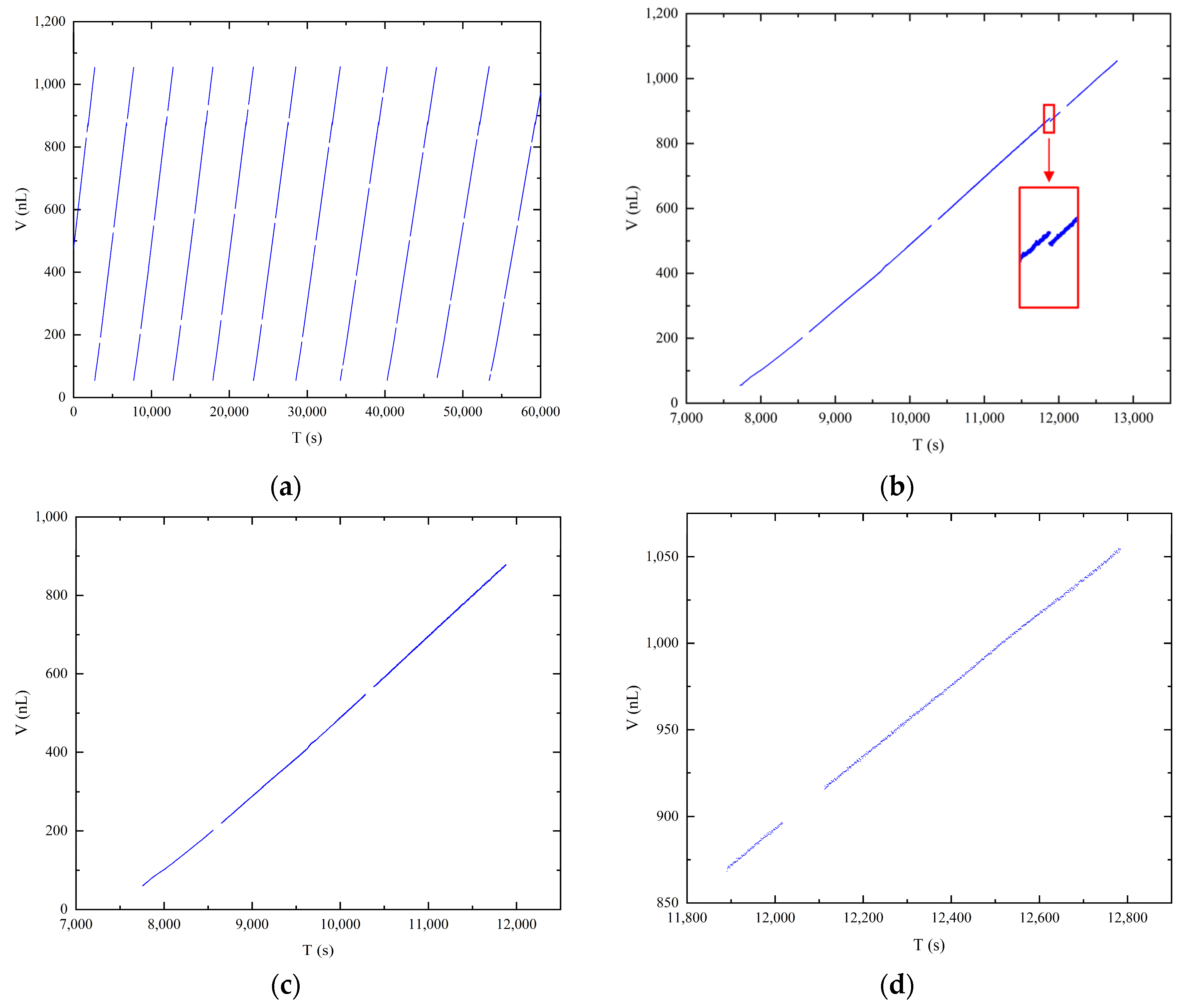
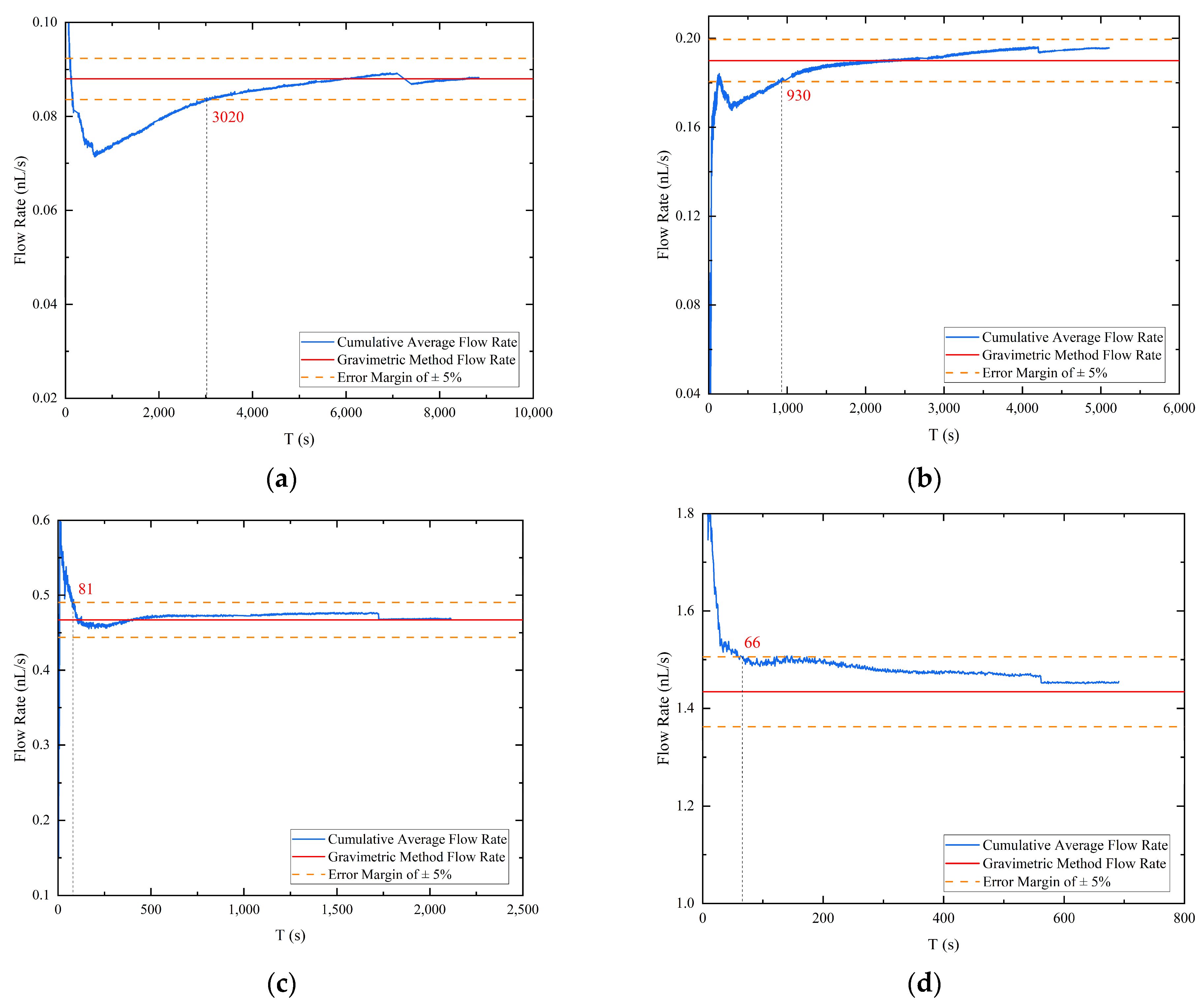
| Property | Symbol | Value at 298 K |
|---|---|---|
| Density | ρ | 1518.48 kg m−3 |
| Viscosity | μ | 0.03246 Pa s |
| Surface Tension | γ | 0.0359 N m−1 |
| Electrical Conductivity | κ | 0.921 S m−1 |
| Relative Permittivity | εr | 12.25 |
| Pipeline Design | Material | Type | Size |
|---|---|---|---|
| Liquid Conveying Pipe | Peek | Inner diameter | 0.1 mm |
| Length | 300 mm | ||
| Emitter | Stainless steel | Inner diameter | 0.13 mm |
| Length | 25 mm | ||
| Liquid Level High Difference * | 150 mm |
| Pressure Differential | Mass of Droplet | Time | Average Volume Flow |
|---|---|---|---|
| 2600 Pa | 1.5 mg | 10,643 s | 0.09 nL/s |
| 1.5 mg | 11,554 s | 0.09 nL/s | |
| 1.5 mg | 11,505 s | 0.09 nL/s | |
| 3000 Pa | 1.5 mg | 5062 s | 0.20 nL/s |
| 1.5 mg | 5108 s | 0.19 nL/s | |
| 1.5 mg | 5206 s | 0.19 nL/s | |
| 4000 Pa | 1.5 mg | 2093 s | 0.47 nL/s |
| 1.5 mg | 2114 s | 0.47 nL/s | |
| 1.5 mg | 2137 s | 0.46 nL/s | |
| 6000 Pa | 1.5 mg | 1051 s | 0.94 nL/s |
| 1.5 mg | 1061 s | 0.93 nL/s | |
| 1.5 mg | 1072 s | 0.92 nL/s | |
| 8000 Pa | 1.5 mg | 684 s | 1.44 nL/s |
| 1.5 mg | 689 s | 1.43 nL/s | |
| 1.5 mg | 693 s | 1.40 nL/s |
| Pressure Differential | Mass of Droplet (the Gravimetric Method) | Mass of Droplet (the Image Processing Technology) | Relative Error |
|---|---|---|---|
| ~2600 Pa | 1.5 mg | 1.516 mg | 1.06% |
| ~3000 Pa | 1.5 mg | 1.517 mg | 1.13% |
| 1.5 mg | 1.517 mg | 1.14% | |
| 1.5 mg | 1.519 mg | 1.23% | |
| 1.5 mg | 1.518 mg | 1.22% | |
| ~4000 Pa | 1.5 mg | 1.503 mg | 0.17% |
| 1.5 mg | 1.505 mg | 0.34% | |
| 1.5 mg | 1.504 mg | 0.29% | |
| 1.5 mg | 1.506 mg | 0.41% | |
| ~6000 Pa | 1.5 mg | 1.519 mg | 1.22% |
| 1.5 mg | 1.522 mg | 1.45% | |
| 1.5 mg | 1.521 mg | 1.30% | |
| 1.5 mg | 1.520 mg | 1.44% | |
| ~8000 Pa | 1.5 mg | 1.527 mg | 1.77% |
| 1.5 mg | 1.529 mg | 3.15% |
Disclaimer/Publisher’s Note: The statements, opinions and data contained in all publications are solely those of the individual author(s) and contributor(s) and not of MDPI and/or the editor(s). MDPI and/or the editor(s) disclaim responsibility for any injury to people or property resulting from any ideas, methods, instructions or products referred to in the content. |
© 2023 by the authors. Licensee MDPI, Basel, Switzerland. This article is an open access article distributed under the terms and conditions of the Creative Commons Attribution (CC BY) license (https://creativecommons.org/licenses/by/4.0/).
Share and Cite
Luo, J.; Yang, C.; Shen, Y. Rapid Calibration of Nanoliter per Second Flow Rate by Image Processing Technology. Micromachines 2023, 14, 1189. https://doi.org/10.3390/mi14061189
Luo J, Yang C, Shen Y. Rapid Calibration of Nanoliter per Second Flow Rate by Image Processing Technology. Micromachines. 2023; 14(6):1189. https://doi.org/10.3390/mi14061189
Chicago/Turabian StyleLuo, Jiawei, Cheng Yang, and Yan Shen. 2023. "Rapid Calibration of Nanoliter per Second Flow Rate by Image Processing Technology" Micromachines 14, no. 6: 1189. https://doi.org/10.3390/mi14061189
APA StyleLuo, J., Yang, C., & Shen, Y. (2023). Rapid Calibration of Nanoliter per Second Flow Rate by Image Processing Technology. Micromachines, 14(6), 1189. https://doi.org/10.3390/mi14061189







